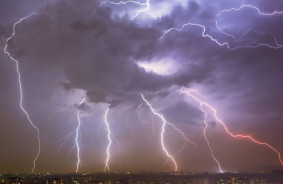Across the globe, people are observing that rainfall and drought patterns are becoming increasingly erratic. Intense precipitation events are occurring more frequently, while dry spells are lasting longer and are becoming more severe. A new study provides the first systematic observational evidence that human-induced climate change is making precipitation patterns more variable worldwide.
Published in the journal Science on July 26, a collaborative study by the Institute of Atmospheric Physics (IAP) of the Chinese Academy of Sciences, the University of the Chinese Academy of Sciences (UCAS), and the UK's Meteorological Office, titled “Anthropogenic Intensification of Precipitation Variability Over the Past Century,” shows a systematic increase in precipitation variability since the 1900s, spanning from global to regional scales and from daily to intra-seasonal timeframes.
Precipitation variability refers to the irregularity in timing and amounts of rainfall. Higher variability indicates that precipitation is distributed more unevenly over time, resulting in wetter and drier periods. In some regions, the amount of rainfall that normally occurs in a year can fall within a few days, leading to prolonged dry spells interspersed with heavy downpours, while droughts and floods rapidly alternate.
Climate models predicted that variability would increase with future warming, but this study confirms that this trend has emerged only in the last century.
The researchers found that the variability of rainfall amounts has increased by more than 75% since the 1900s across the studied land areas, particularly in Europe, Australia, and eastern North America. They discovered that daily precipitation variability has risen globally by 1.2% per decade.
“The increase in precipitation variability is primarily linked to anthropogenic greenhouse gas emissions, which have resulted in a warmer, more humid atmosphere. This means that even if atmospheric circulation remains unchanged, the added moisture in the air leads to more intense rainfall and sharper fluctuations. Regional atmospheric circulation also influences these changes on decadal timescales,” says Dr. Zhang Wenxia, the lead author of the study and an associate professor at IAP.
According to Dr. Wu Peili, a scientific expert at the Meteorological Office and a co-author of the study, rapid extreme shifts in climate models present significant risks to the climate resilience of infrastructure, economic development, ecosystem functioning, and carbon absorption. He emphasizes the need for immediate “adaptive” measures.
Source: SciTechDaily














Comments (0)
There are no comments for now